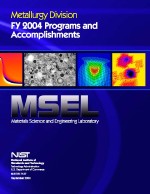Metallurgy Division Publications - NISTIR 7127Executive Summary |
|
This report describes the major technical activities and accomplishments in the Metallurgy Division of NIST Materials Science and Engineering Laboratory in FY 2004 (October 2003 through September 2004). In this report, we have tried to provide insight into how the capabilities of the NIST Metallurgy Division are being used to solve problems important to the national economy and the materials metrology infrastructure, and how we establish new programs in response to changes in national priorities. We welcome feedback and suggestions on how we can better serve the Nation and encourage increased collaboration to this end. Mission of the NIST Metallurgy DivisionOur mission is to provide critical leadership in the development of measurement methods, standards, and fundamental understanding of materials behavior needed by U.S. materials users and producers to become or remain competitive in the changing global marketplace. As a fundamental part of this mission, we are responsible not only for developing new measurement methods with broad applicability across materials classes and industries but also for working with other federal agencies and industrial sectors to develop and integrate measurements, standards, software tools, and evaluated data for specific, important applications. Establishing Priorities We examine a wide range of research opportunities and set priorities based on the following criteria: the match to the NIST mission, the magnitude and immediacy of industrial need, the determination that the NIST contribution is critical for success, the anticipated impact relative to our investment, the ability to respond in a timely fashion with high-quality output, and the opportunity to advance mission science. We make such decisions using a variety of methods, including roadmapping activities, workshops, technical meetings, standards committee participation, and consultation with individuals representing U.S. industry and other federal agencies. Technology trends strongly influence the technical directions addressed by NIST. We prefer to work in rapidly evolving technologies, where advances in measurement science are needed to understand the limitations on system behavior, and, thus, our contributions are likely to have a substantial impact on the course of technology. For NIST as a whole and the Metallurgy Division in particular, we are committed to having an impact on nanotechnology, homeland security, health care, and information technology. Over the last two years, we have shifted substantial resources into the areas of nanomagnetics, nanomechanics, and the application of thermodynamics and kinetics to nanostructure fabrication, and into a new MSEL Program in Safety and Reliability of Infrastructure Materials with a focus on homeland security and critical infrastructure protection. The Division highlights and the individual project descriptions demonstrate our rapid progress in these and other longer-standing areas. Research PortfolioOur 2004 research portfolio focuses on fulfilling current and future measurement needs of the magnetic data storage, microelectronics packaging, automotive, optoelectronics, and energy distribution industries, on establishing national traceable hardness standards needed for international trade, and on developing new measurements that could underpin nanotechnology development. Our output consists of a variety of forms, from a fundamental understanding of materials behavior to measurement techniques conveyed through the scientific literature and oral presentations, standard reference materials, evaluated data and online databases, software tools, and sensors for on-line process control. Division Structure and ExpertiseThe Division is composed of 34 scientists, supported by 5 technicians, 6 administrative staff members, and more than 80 guest scientists, and it is organized into five groups that represent the Division’s core expertise in Metallurgical Processing, Electrochemical Processing, Magnetic Materials, Materials Structure and Characterization, and Materials Performance. However, by virtue of the interdisciplinary nature of materials problems in the industrial and metrology sectors that we serve, Program teams are assembled across group, division and laboratory boundaries and with external partners to best meet project goals. We are committed to assembling the expertise and resources to fulfill our technical goals with the speed and quality necessary to have the desired impact. Recognition for Division StaffWe are proud of the accomplishments of the Metallurgy Division staff in delivering the mission science tools — measurements, standards, data, modeling — needed by our customers. In FY2004, Division members were recognized for the impact and quality of their work by a wide range of organizations, including the award of two Gold Medals, the highest honor conferred by the Department of Commerce, and one Silver Medal from the Department of Commerce and NIST.
Carol A. Handwerker, Chief, Metallurgy Division
|
|
|
|
Metallurgy Division of MSEL | metallurgy@nist.gov Home | Personnel | Research Opportunities The National Institute of Standards and Technology (NIST) is an agency of the U.S. Commerce Department. Privacy policy / security notice / accessibility statement / Disclaimer / Freedom of Information Act (FOIA) / No Fear Act Policy / ExpectMore.gov (performance of federal programs) / NIST Information Quality Standards |

